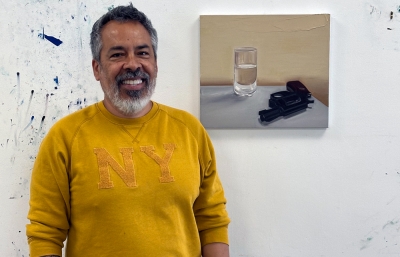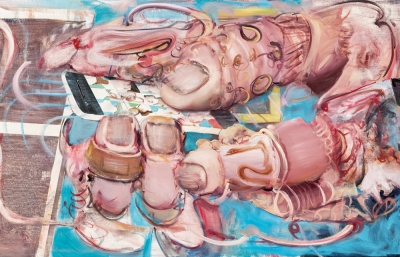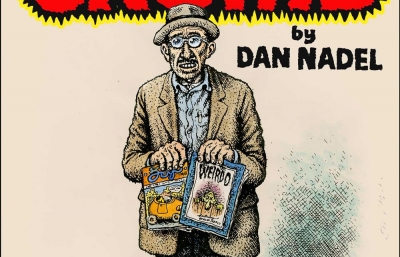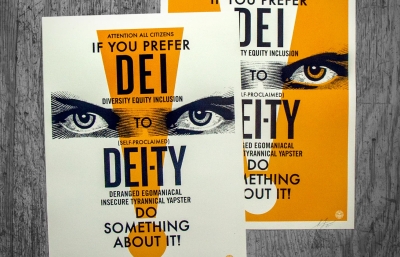The premise based on Aristotle’s mimesis proposing that, "Art imitates life," is manifest in most of the figurative works we see. While the Greek philosopher and polymath focused on the relationship between nature and art, this connection has eventually evolved into much more complex correlation.

Fast forward 2,400 years since Aristotle's observations, where Maja Djordjevic finds herself imitating the imperfect, flawed aesthetic of primitive computer screens in her vibrant, energetic images. Painted entirely by hand, using thick and glossy layers of enamel paint, her work carries a sense of urgency to create completely, unrestricted by traditional standards. Not depicting life as she sees it directly, but as she used to interpret it on her computer screen while growing up in Serbia in the 2000s, she is turning the tables and using the heavily pixelated digital images as a reference to her work.
Connecting with Generation Y worldwide, her work brings back memories of a not-so-distant past when Microsoft Paint or similar software was the primary tool to explore creative, computer possibilities, but also, question social norms and test the tolerance of her surroundings. Providing an endless source of art materials and the limited, and, at that point, unheard aggregate of functions, this software and moment in time was a key to an army of young artists exploring the art world. Maja Djordjevic is here to prove it, with her wicked visuals taking over the world from Belgrade, Athena and London, all the way to Miami and LA.

Sasha Bogojev: How did you develop this unique aesthetic?
Maja Djordjevic: When I was a child, while most kids were engaged in various activities such as sports, languages, and music, I was solely interested in drawing and painting. I attended art school since the age of seven until I enrolled in the Design High School, Department of Industrial Design and Interior; but deep inside, I felt like a painter, so I continued my education at the Faculty of Fine Arts in Belgrade, Department of Painting, where I finished my graduate and master studies. Everything went very smoothly.
Do you remember when you started using the pixelated interface as the base for your work?
Of course! I started to draw in Microsoft Paint when I was in elementary school. My classmates and I used to gather around someone’s computer and compete for who would be better at drawing a castle, dinosaur, the universe, a magic cat or an upside-down boat while using as many tools as Paint had to offer.
Many years later, during my graduate studies, I started to make doodles in Paint and keep my visual diary in that way. Somehow, I found this easier as opposed to getting all my materials out and preparing for work, by which time my inspiration could have been already gone. I also must admit that, back in those days, I spent a lot of time surfing on my computer. The university I studied is very traditional, meaning that if your major is Painting, you have to paint oil on canvas; however, I found it amusing to connect my visual diary with it. This is how I came up with the idea of painting a screen picture in a traditional way.

What attracts you to such a raw and unrefined aesthetic?
Precisely that rawness. It immediately brings me back to my childhood: Sega, Paint, Space Invaders and all arcade games. This is what we get.
Although they all appear very digital, the works are actually fully hand made, right?
Completely handmade. This is what excites me about my work. I paint pixels by hand, using only a brush and looking at the screen picture, without the help of tapes, projectors or standstills.
What type of materials do you use, and how much of the process is actually digital?
There are two distinct processes in my work. The first one involves maintaining a diary by drawing doodles on my computer, phone or tablet, and I find that really amusing. I draw my girl in all sorts of situations, be they sad, happy, loving, shocking, joyful, perverse or beautiful, and I try to show them in the most bizarre way, with the goal of ultimately making myself laugh. I must say that I am quite successful at that. The second process is painting the very same digital image on canvas, using enamel paint. I chose enamel paint as a medium because it helps me achieve a high level of glow that is comparable to the screen itself. Okay, I am aware that enamel is highly toxic; however, it is the most suitable for achieving such an effect – that’s why I never paint without a mask. On top of that, there is the pain in my back and my knees given that everything needs to be painted on the floor because of the enamel itself and its slow drying process. It can take up to 24 hours for just one layer to dry. As I mentioned already, pixel by pixel. I strive to make them look as precise as possible, although, I love every single imperfection as well.
My greatest satisfaction is when, after some time, I put the very same canvas (usually in a large format) upright and that small digital image becomes alive.

Where does the main character, the naked woman, come from, and does she stands for anyone or anything?
Besides the above-mentioned dinosaurs, fairies, and cats, as children, we used to draw the things boys and girls have under their clothes. It amused us a lot, despite the feeling that we were doing something terrible and forbidden. Paint gave us the possibility to delete everything with just one click in case our parents entered the room. It’s not quite the same as drawing on a piece of paper – it was much more difficult for our parents to uncover us.
When I started using Paint again during my studies, she simply emerged again in the same naked fashion. I decided to leave her that way. I tried putting clothes on her, but she did not carry the same weight as she carries today, and rather looked like an illustration from a children's book. In most situations she represents me, although I often tell stories of other women and men through her. I like to mess around with how she would react through the prism of other people.
I always wonder if she's excited, shocked, or angry. Is that part of her appeal?
She is simply loud. Not only when she is excited, shocked and angry, but also when she is in love, happy, and feeling romantic. She just has to express every emotion she feels out loud.

These themes of nudity, sex and debauchery are pretty common in your work. How often did you have to censor it, and how do you usually react to those demands?
I never tried to censor anything, but rather tried to mask it with joyful bright colors. People’s first reaction is often along the lines of, “Wow, that looks so cheerful,” or comments such as, “This is just right for the kids’ room,” as if they didn’t realize at first glance what is hidden behind all that. Although I must say that I recently received a few comments with regards to nudity. I find this amusing and it also gives me a challenge to hide that vulgar (haha) little black square. But okay, there is always a solution for that; for instance, it can be covered by one of my daisy flowers.
Is there a connecting thread between the work you've made for your recent Dio Horia exhibition?
Marina Vranopoulou, the founder of Dio Horia galleries, discovered my work after I finished my studies. We have been continuously collaborating ever since, five years now, and I have been visiting Greece all these years. In the previous four years I visited Mykonos, where the first gallery is based, and did an art residency and exhibited several times. This year, I spent two-and-a-half months in Athens working on the latest show, I Am Always a Different Person. I am pretty sure that the time I spent there is somehow reflected in my latest paintings as well. This exhibition is all about love, excitement, fear, the ephemerality of all emotions—and how to face all the challenges that reveal the magic of existence.

How did you like living and working in Athens, and how did that inform your new work?
Athens is beautiful, and just everything you may need. I had a great studio, nice weather, olive, pomegranate, orange and lemon trees on every corner. I drank Freddo espresso with plenty of sugar every day. I was surrounded by beautiful people and had Dio Horia gallery’s very inspiring exhibition space at my disposal. However, best of all, was the fact that some of the highest quality enamel paint is available in Greece. I haven’t had the opportunity to work with such intensive enamel colors until now. That was a great advantage.
What would you say is the latest development in your work and the imagery you’re using?
What is new about these works is that a boy appears for the first time. My girl fell in love and is displaying her emotional state. Okay, my emotional state. I am not able to express that through words as effectively as through my paintings. However, here are some sentences, in my broken-English, that can be found on the paintings themselves that will help you understand how my blonde girl is feeling: “you are the best of my love,” “halp me to love you forever,” “all about you,” “he will be daisy like me,” “love me tomorrow,” “stand up for me,” and “I AM ALWAYS DIFFERENT PERSON.”









